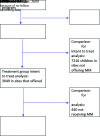A Coaching Model to Promote Economic Mobility and Child Developmental Outcomes
- PMID: 34927209
- PMCID: PMC9647933
- DOI: 10.1542/peds.2020-018473
A Coaching Model to Promote Economic Mobility and Child Developmental Outcomes
Abstract
Objectives: Children growing up in poverty experience worse developmental outcomes than their more economically advantaged peers. Whether Mobility Mentoring, a program focused on building parent executive function to promote economic mobility, results in improved child developmental outcomes is not known.
Methods: This study population was drawn from children enrolled in Washington State's public, income-qualified prekindergarten program and their families. We used a quasi-experimental, preintervention-postintervention design with 2 contemporaneous comparison groups: children in the same settings whose families did not receive the intervention and children in settings in which the intervention was not offered. Primary outcomes are improvement in each of the 6 dimensions of the Teaching Strategies GOLD (TSG) measure (social-emotional, physical, cognitive, language, literacy, and mathematics) and meeting or exceeding "widely held expectations" in all of these 6 dimensions.
Results: Within sites that offered the coaching program, children whose parents received the program (n = 2609) showed gains in 2 of 6 TSG dimensions compared with children (n = 440) whose parents did not, and also met or exceeded widely held expectations. TSG outcomes of all children in sites offering the intervention (n = 3049) did not differ from those of children in sites that did not (n = 7216).
Conclusions: Findings provide sufficient evidence of a positive impact of Mobility Mentoring on child development to merit further study. If substantiated, building parental executive function may improve child outcomes as well as enhance progress toward economic self-sufficiency, and potentially be more engaging than traditional family support programs.
Copyright © 2022 by the American Academy of Pediatrics.
Conflict of interest statement
FINANCIAL DISCLOSURE: The authors have indicated they have no financial relationships relevant to this article to disclose.
Figures
References
-
- Le Menestrel S, Duncan G, eds; National Academies of Sciences, Engineering, and Medicine; Division of Behavioral and Social Sciences and Education; Committee on National Statistics; Board on Children, Youth, and Families; Committee on Building an Agenda to Reduce the Number of Children in Poverty in Half in 10 Years . A Roadmap to Reducing Child Poverty. Washington, DC: National Academies Press; 2019 - PubMed
-
- Heckman JJ, Karapakula G. Intergenerational and intragenerational externalities of the Perry Preschool Project. 2019. Available at: https://www.nber.org/papers/w25889. Accessed June 8, 2020
-
- Perrin EC, Leslie LK, Boat T. Parenting as primary prevention. JAMA Pediatr. 2016;170(7):637–638 - PubMed
-
- Babcock E. Using brain science to design new pathways out of poverty. 2014. Available at: http://s3.amazonaws.com/empath-website/pdf/Research- UsingBrainScienceDe.... Accessed June 8, 2020
-
- Mullainathan S, Shafir E. Scarcity: Why Having Too Little Means So Much. New York, NY: Picador; 2013
MeSH terms
LinkOut - more resources
Full Text Sources
Medical
Miscellaneous



